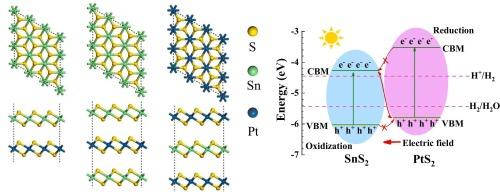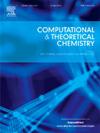SnS2/PtS2层状异质结光催化剂在景观环境修复中的应变工程:理论计算
IF 3
3区 化学
Q3 CHEMISTRY, PHYSICAL
引用次数: 0
摘要
异质结光催化剂已成为一种很有前途的环境污染物修复方法。在本研究中,采用SnS2单层膜和PtS2单层膜构建异质结(SnS2/PtS2、SnS2/PtS2/SnS2和PtS2/SnS2/PtS2)。通过第一性原理计算综合分析了它们的结构稳定性、电子性质、层间电荷转移机制和光学行为。结果表明,所有的异质结都具有很强的结构稳定性。这些异质结构的间接带隙在1.561 ~ 1.688 eV之间,表现出ii型带对准特征。光学分析表明,SnS2/PtS2/SnS2异质结在可见光范围内具有优异的光吸收效率。此外,这种异质结显示出最低的过电位,表明光催化水分解能力增强。这些见解为异质结光催化剂的合理设计提供了有价值的指导。本文章由计算机程序翻译,如有差异,请以英文原文为准。

Strain engineering of SnS2/PtS2 layered heterojunction photocatalysts for landscape environmental remediation: theoretical calculations
Heterojunction photocatalysts have emerged as a promising approach for the remediation of environmental pollutants. In this investigation, SnS2 monolayer and PtS2 monolayer were employed to construct heterojunctions (SnS2/PtS2, SnS2/PtS2/SnS2, and PtS2/SnS2/PtS2). First-principles calculations were conducted to comprehensively analyze their structural stability, electronic properties, interlayer charge transfer mechanisms, and optical behavior. The results demonstrate that all examined heterojunctions possess robust structural stability. The indirect band gaps of these heterostructures range between 1.561 eV and 1.688 eV, exhibiting characteristic type-II band alignment. Optical analyses indicate that the SnS2/PtS2/SnS2 heterojunction achieves superior light absorption efficiency within the visible spectrum. Furthermore, this heterojunction displays the lowest overpotential, indicative of enhanced photocatalytic water-splitting capabilities. These insights offer valuable guidance for the rational design of heterojunction photocatalysts.
求助全文
通过发布文献求助,成功后即可免费获取论文全文。
去求助
来源期刊

Computational and Theoretical Chemistry
CHEMISTRY, PHYSICAL-
CiteScore
4.20
自引率
10.70%
发文量
331
审稿时长
31 days
期刊介绍:
Computational and Theoretical Chemistry publishes high quality, original reports of significance in computational and theoretical chemistry including those that deal with problems of structure, properties, energetics, weak interactions, reaction mechanisms, catalysis, and reaction rates involving atoms, molecules, clusters, surfaces, and bulk matter.
 求助内容:
求助内容: 应助结果提醒方式:
应助结果提醒方式:


